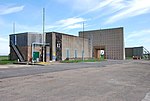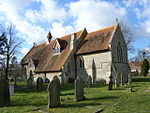Wotton railway station was a small station in Buckinghamshire, England, built by the Duke of Buckingham in 1871. Part of a private horse-drawn tramway designed to carry freight from and around his lands in Buckinghamshire, Wotton station was intended to serve the Duke's home at Wotton House and the nearby village of Wotton Underwood. In 1872 the line was extended to the nearby village of Brill, converted to passenger use, equipped with steam locomotives, and renamed the Brill Tramway. In the 1880s, it was proposed to extend the line to Oxford, but the operation of the line was instead taken over by London's Metropolitan Railway.
Although situated in an unpopulated area, Wotton station was relatively well used. It saw the highest passenger numbers of any station on the line other than the terminus at Brill railway station and the junction with the main line to London at Quainton Road railway station, and it also carried large quantities of milk from the area's dairy farms. In 1906 the Great Western and Great Central Joint Railway (commonly known as the Alternative Route) was opened, crossing the Brill Tramway at Wotton. Although the lines were not connected, a station (also named Wotton) was built on the new line very near the existing Wotton station; the two stations shared a stationmaster.In 1933 the Metropolitan Railway, which leased the line, was taken into public ownership and became the Metropolitan line of London Transport. Despite being a small rural station 49 miles (79 km) by train from the City of London, Wotton became a station on the London Underground. Frank Pick, the Chief Executive of the London Passenger Transport Board, aimed to abandon freight operations on the London Underground network, and saw no way in which the more distant parts of the former Metropolitan Railway could ever become viable passenger routes. As a result, all passenger services north of Aylesbury were withdrawn between 1935 and 1936; the last trains on the Brill Tramway ran on 30 November 1935. The line then reverted to the descendants of the Duke of Buckingham, but having no funds and no rolling stock they were unable to operate it. On 2 April 1936, the line's entire infrastructure, including Wotton station, was sold for scrap at auction. Except for a small building which once housed the Brill Tramway's forge, all the station buildings at Wotton have been demolished.







